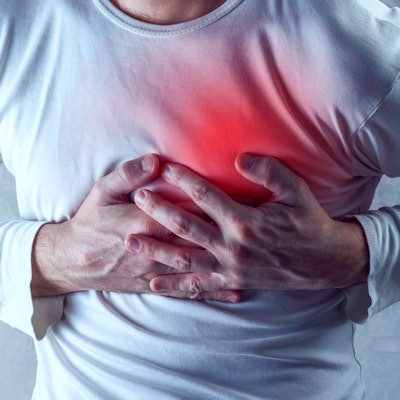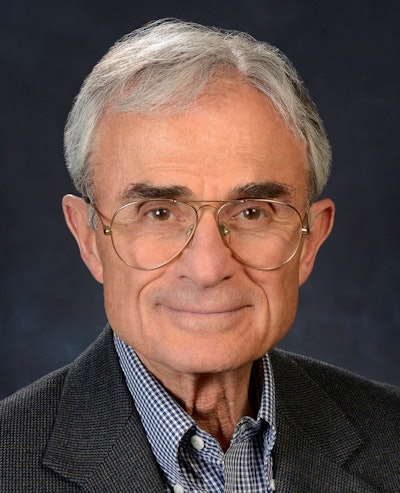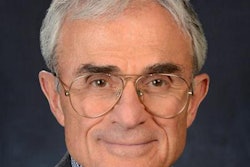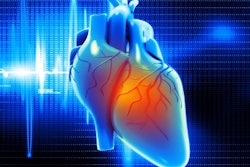
The use of coronary CT angiography (CCTA) to evaluate chest pain in the emergency department has grown exponentially, but clinicians are still using myocardial perfusion imaging (MPI) far more frequently, according to research published online February 15 in the American Journal of Roentgenology.
Reviewing the 2006-2015 U.S. Medicare databases, researchers from Thomas Jefferson University noted that the use rate of CCTA for patients in the emergency department increased steeply, with a compound annual growth rate of 35%. Yet the total number of annual CCTA exams interpreted did not reach even one-tenth of the number of MPI exams read during the same time frame -- despite the accumulation of research showing the advantages of CCTA (AJR, February 15, 2018).
"Physicians are slowly but surely coming to realize that CCTA is the better of the imaging tests for emergency department patients with acute chest pain," first author Dr. David C. Levin told AuntMinnie.com. "Even though the numbers for CCTA use are much lower [than they are for MPI or stress echocardiography exams], its use in that setting is growing rapidly, and I think that's going to continue."
CCTA on the rise
A standard evaluation of patients admitted to the emergency department with acute chest pain typically involves observation, a serial electrocardiogram (ECG), cardiac enzyme measurements, and cardiac imaging. Traditionally, myocardial perfusion imaging has been the imaging modality of choice, but physicians have been considering CCTA as a more appropriate alternative in recent years.
 Dr. David C. Levin from Thomas Jefferson University.
Dr. David C. Levin from Thomas Jefferson University.Numerous clinical trials comparing the two imaging techniques have confirmed that CCTA has several advantages over MPI in determining a patient's risk for coronary artery disease: shorter time to diagnosis and length of stay in the emergency department, greater likelihood of direct discharge, fewer complications, improved prognostic performance, and lower emergency department costs.
These studies have also shown that MPI produces an excessive number of false-positive and false-negative results -- leading to unnecessary invasive coronary angiograms, the authors noted. On the other hand, CCTA has a negative predictive value approaching 100%.
"Virtually all of the studies point to CCTA being the better test for acute chest pain," Levin said.
With interest in CCTA surging, the investigators sought to determine the precise utilization rate of cardiac imaging exams -- including CCTA, MPI, and stress echocardiography -- by physicians when assessing patients presenting to the emergency department with acute chest pain. For this task, they examined the U.S. Medicare Part B Physician/Supplier Procedure Summary (PSPS) files for 2006-2015, which covered all traditional Medicare fee-for-service beneficiaries.
Cardiac imaging trends
Among the various imaging exams, MPI was the most commonly used by far, followed by stress echocardiography. Although the total number of CCTA exams was relatively low, its utilization rate was the only one that turned out to be higher in 2015 than at its starting point in 2006. Nevertheless, the usage rate of MPI was still 11.6 times higher than that of CCTA in 2015.
| Emergency dept. rates of cardiac imaging exams for acute chest pain | ||
| Exam | 2006 | 2015 |
| Myocardial perfusion imaging | 22,342 | 22,338 |
| Stress echocardiography | 3,544 | 3,520 |
| Coronary CT angiography | 126 | 1,919 |
Neither the number of MPI exams nor stress echocardiograms that were performed changed much by the end of the nine-year period. In contrast, the use of CCTA increased more than 15-fold. This surge in CCTA use was most attributable to radiologists; they interpreted 1,503 more CCTA exams in 2015 than they did in 2006. Cardiologists, on the other hand, only read 287 more CCTA exams in 2015 than in 2006.
Furthermore, radiologists also read the lion's share of MPI exams but fewer stress echocardiography exams. In 2015, they interpreted 78% of the MPI studies and 83% of the CCTA scans, whereas cardiologists read nearly all of the stress echocardiography exams. Radiologists are reading increasingly more CCTA scans than cardiologists are every year, and not just in the emergency department.
"It's one area where the radiologists are outstripping the competition," Levin said. "When CCTA first came out, cardiologists were reading a lot more than radiologists were, but now it's just the opposite."
This shift is partly due to the 24/7 availability of radiologists for reading scans, which is particularly relevant for emergency department cases, he said. But it is also now common to set aside all CCTA scans exclusively for radiologists to examine at hospitals including Thomas Jefferson University Hospital.
Overlooking new evidence
The current study revealed that physicians ordered far more MPI than CCTA exams for acute chest pain throughout the 2006-2015 period, despite mounting clinical backing for CCTA use. This propensity for using MPI suggests that physicians are not fully acting upon recent evidence supporting CCTA, according to the authors.
Why are physicians still using MPI much more often than CCTA to evaluate acute chest pain in the emergency department?
One possible explanation is the heavier financial burden of using CCTA instead of clinical evaluation alone, although research has also shown that most of the differences in cost between imaging exams per se are not statistically significant.
In addition, shifting practice to account for new evidence takes time, Levin said.
"Old habits die hard," he noted. "For many years, the standard way to evaluate acute chest pain involved MPI or stress echocardiography, and I think some people still haven't gotten the word."
Levin also cited other factors that might account for this tendency: CCTA is more labor-intensive than MPI, reimbursement rates for the exam are not very good, and insurance carriers are denying (the relatively new) CCTA exams more so than MPI exams.
Finally, some guidelines for cardiac imaging remain unchanged, which could be deterring physicians from turning to CCTA. For example, the American College of Radiology (ACR) Appropriateness Criteria for evaluating chest pain suggestive of acute coronary syndrome lists CCTA as a 6, or "possibly appropriate," whereas MPI and stress echocardiography both have a higher rating of "appropriate" (7 to 9).
"Why the rating for CCTA is so low is not clear, but [the ACR is] saying that the use of CCTA for these patients is indeterminate," he said. "I hope the ACR will take heed of new research and consider revising the CCTA rating for this scenario such that it is rated higher than MPI and stress echocardiography."
To promote the use of CCTA over MPI, radiologists should educate their emergency medicine colleagues about the benefits of using CCTA to evaluate patients with chest pain, he said.
The authors' examination of cardiac imaging trends is ongoing and not limited to the emergency department, instead reaching the entirety of healthcare practices as well.
"Upon a brief look at the Medicare data for 2016, the overall use of CCTA is continuing to go up," Levin said. "I think that the utilization rate for MPI and stress echocardiography in the emergency department will probably stay stable, whereas the CCTA utilization rate will keep going up rapidly."




















